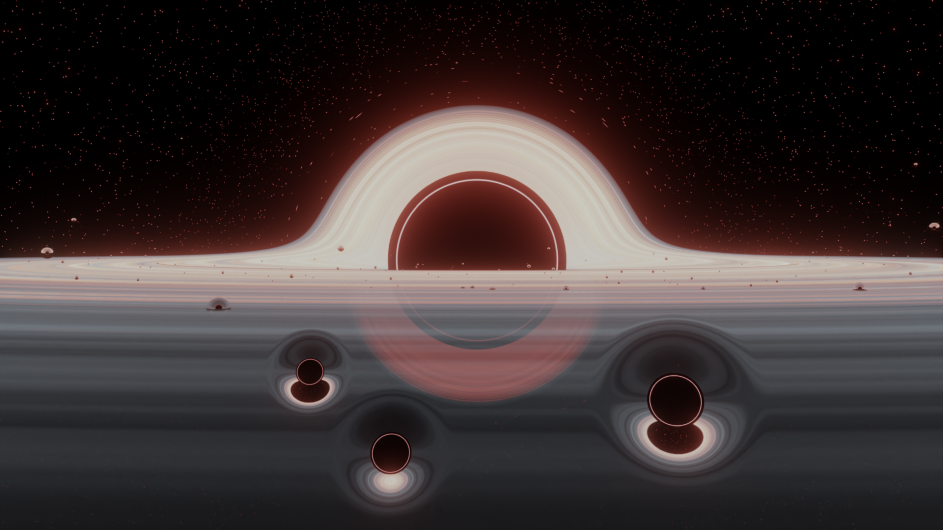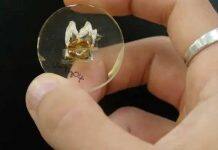The biggest black hole collisions detected by LIGO may have arisen from a flat disk of gas in a young galaxy with a supermassive black hole at its center, says a new study in Nature.


Nearly 100 black hole mergers have been discovered since the LIGO gravitational wave observatory came online in 2015. But few have captivated astronomers as much as GW190521, the colossal merger detected by the LIGO and Virgo observatories three years ago.
A pair of black holes 85 times and 66 times as massive as the sun collided in the biggest merger detected so far by gravitational waves. Until then, the weight limit for black holes formed from stars collapsing in on themselves was thought to be 50 solar masses, or the weight of about 333,000 Earths.
The monstrous size of this merger wasn’t its only puzzling feature. The black hole pair appeared to plunge into each other on an elliptical orbit, unlike the circular orbits of previously observed mergers. They also seemed to be spinning unusually fast, on a tilted axis, and may have produced a flash of light upon striking, which, if confirmed, could be the first observed flare from a black hole merger.
In a new study in Nature, astronomers explain how this spectacular event might have arisen. Most galaxies, including our own, have a supermassive black hole at their core, a bottomless pit so dense that nothing escapes, not even light. The supermassive black hole anchoring our Milky Way is four million solar masses, but elsewhere they can run into the billions.
These behemoth black holes are thought to have originated in the early universe from the collapse of large gas clouds in protogalaxies billions of years ago. Lighting up the gas around them, these super-sized supermassive black holes are known as quasars. In one of these bright, distant galaxies, conditions may have been right to produce a merger like GW190521, the researchers hypothesize.
“We think quasars, or what we call active galactic nuclei, are potential factories for massive black hole mergers like this one,” said Zoltan Haiman, an astronomy professor at Columbia and co-author of the study.
Swirling around thesupermassive black hole at the center of a quasar is an ultra-thin layer of gas and dust. Haiman compares this flat disk of gas to a conveyor belt that gathers up black holes of all sizes and shuttles them toward the hungry mouth of the monster black hole at the galaxy’s center. Because the gas has friction, it keeps the smaller black holes from flying off in all directions.
Stuck on this flat plane, the black holes pile up and repeatedly smash into one another, growing bigger and bigger until they reach the gargantuan size detectable by LIGO. This idea of a conveyor-like gas disk where black holes cannibalize each other and grow even more monstrous was developed by Haiman in an earlier set of papers with Columbia physics professor Brian Metzger, then-postdoc Nick Stone, and then-lecturer Imre Bartos, who is a co-author on the current study.
Under this proposed model of a black hole factory embedded in a gas disk, the weird effects observed in the recent GW190521 merger are expected, said Haiman.
He ticked off the evidence: “The black holes can be gigantic because they can merge multiple times, building up higher-mass black holes. The black holes pull in gas from the disk, which makes them spin faster. I’m still not convinced a flare came out of the merger, but it could have been produced by ambient gas swallowed by the black hole pair after they crashed.”
The most compelling detail is also the focus of the Nature paper: the high probability that a third black hole knocked into the pair just before they collided, producing that puzzling elliptical orbit and tilted orbital plane observed in the GW190521 merger. The researchers show that a third black hole striking the merging pair throws their circular orbit into an elliptical one, while setting their orbital axis askew, giving the pair an Earth-like tilt.
“This is the only model I’ve seen that can account for several of the unusual properties of this merging black hole pair,” said Metzger. “It makes sense that this pair would come together in a flattened disk of tightly packed black holes which are commonly found in quasars.”
Just 1 percent of galaxies have a quasar, or active supermassive black hole, at their center. The detection of other black hole mergers in quasars will be needed to tell whether the theory holds up. LIGO and other current gravitational wave detectors are not yet sensitive enough, said Haiman, but future detectors with mirrors spaced farther apart could be up to the task.
The other authors of the study are: Johan Samsing, Niels Bohr Institute at the University of Copenhagen; Daniel D’Orazio, Harvard-Smithsonian Center for Astrophysics; Bence Kocsis, University of Oxford; Nathan Leigh, Universidad de Concepción in Chile; Bin Liu and Martin Pessah of Neils Bohr Institute; and Hiroichi Tagawa, Tohoku University in Japan.








































